by Wikipedia
December 18, 2014
NOTICE: THIS WORK MAY BE PROTECTED BY COPYRIGHT
YOU ARE REQUIRED TO READ THE COPYRIGHT NOTICE AT THIS LINK BEFORE YOU READ THE FOLLOWING WORK, THAT IS AVAILABLE SOLELY FOR PRIVATE STUDY, SCHOLARSHIP OR RESEARCH PURSUANT TO 17 U.S.C. SECTION 107 AND 108. IN THE EVENT THAT THE LIBRARY DETERMINES THAT UNLAWFUL COPYING OF THIS WORK HAS OCCURRED, THE LIBRARY HAS THE RIGHT TO BLOCK THE I.P. ADDRESS AT WHICH THE UNLAWFUL COPYING APPEARED TO HAVE OCCURRED. THANK YOU FOR RESPECTING THE RIGHTS OF COPYRIGHT OWNERS.
This name uses Spanish naming customs: the first or paternal family name is Díaz and the second or maternal family name is de Vivar.
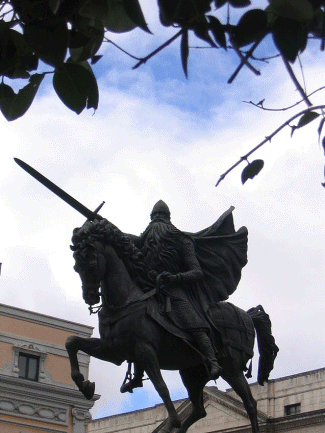
Statue of El Cid in Burgos by Juan Cristóbal González
Prince of Valencia
Reign: 1094–1099
Coronation: 1094
Successor: Jimena Díaz
Spouse: Jimena Díaz
Issue: Diego Rodríguez, Cristina Rodríguez, María Rodríguez
Father: Diego Laínez
Born: c. 1040, Vivar, Burgos
Died: 1099, Valencia
Burial: Burgos Cathedral
Signature:

Rodrigo Díaz de Vivar (c. 1043 – 1099) was a Castilian nobleman and military leader in medieval Spain. He was called El Cid (the Lord) by the Moors and El Campeador (the Champion) by Christians. He is the otherwise real but made legendary national hero of Castile. He was born in Vivar del Cid, a town near the city of Burgos.
Born a member of the minor nobility, El Cid was brought up at the court of King Ferdinand the Great and served in the household of Ferdinand's son Sancho. He rose to become commander and the royal standard-bearer (armiger regis) of Castile upon Sancho's ascension in 1065. He went on to lead the Castilian military campaigns against Sancho's brothers, the rulers of the kingdoms of Leon and Galicia as well as against the Muslim kingdoms in Andalusia. He became famous for his military prowess in these campaigns, and helped enlarge Castilian territory at the expense of the Muslims while driving Sancho's brothers from their thrones. This, however, ended up putting him in a difficult position when suddenly, in 1072, Sancho was murdered and with no legitimate issue, leaving his recently ousted brother, Alfonso, as his only heir and ruler of the reunified empire. Although El Cid continued to serve the crown in the person of Alfonso, who was now Emperor of Spain, he lost his status in court and was held in suspicion. Finally, in 1081, he was ordered into exile.
Rodrigo Díaz found work fighting for the Muslim rulers of Zaragoza, whom he protected from the domination of Aragon and Barcelona, further bolstering his military record and reputation as a leader. He was also victorious in battles against the Muslim rulers of Lérida and their Christian allies, as well as against a large Christian army under King Sancho Ramírez of Aragon. In 1086, Alfonso was defeated by Almoravids from North Africa, and he overcame his antagonism to talk de Vivar into fighting for him again. Over the next several years El Cid set his sights on the kingdom-city of Valencia, operating more or less independently of Alfonso while politically supporting the Banu Hud and other Muslim dynasties opposed to the Almoravids. He gradually increased his control over Valencia; the Islamic ruler, al-Qadir, became his tributary in 1092. However, the Almoravids instigated an uprising that resulted in the death of al-Qadir – he responded by laying siege to the city. Valencia finally fell in 1094 and El Cid established an independent principality in the eastern Mediterranean coast of Spain. He ruled over a pluralistic state with the popular support of both Christians and Muslims.
The final years of El Cid were spent in fighting the Almoravid Berbers. He inflicted the first major defeat on them in 1094 in the plains of Caurte outside Valencia and continued resisting them until his death. Although El Cid himself remained undefeated in Valencia, he suffered a tragedy when his only son and heir, Diego Rodríguez, died fighting against the Almoravids in the service of Alfonso in 1097. After El Cid's death in 1099, his wife, Jimena Díaz, succeeded him as ruler of Valencia, but she had to surrender the principality to the Almoravids in 1102.
Long after his death, El Cid remains an idolised figure in Spain. The character and his name have been immortalized in plays, film, folk tales, songs, and videogames.
Title
The name El Cid (Spanish: [el ˈθið]) is a modern Spanish denomination composed by the article el meaning "the" and Cid which comes from the Old Spanish loan word Çid from the dialectal Arabic word سيد sîdi or sayyid, which means "Lord" or "Master". He could be so addressed by the Mozarabs or by the Arabs serving in his own ranks, and then its transliteration was adopted by the Christians, but no contemporary record referring to Rodrigo as Cid has been found. Arab sources use instead Rudriq, Ludriq al-Kanbiyatur or al-Qanbiyatur (Rodrigo el Campeador).[1] The cognomen Campeador given by his Christian countrymen derives from Latin campi doctor that means "battlefield master". He probably gained it during the campaigns of King Sancho II of Castile against his brothers King Alfonso VI of León and King García II of Galicia. While there are no contemporary documents proving that he was addressed as Cid, there are many Christian and Arab records addressing him as Campeador, even autographs which prove that he used the cognomen himself.[2][3][4][5] The whole combination Cid Campeador is first documented ca. 1195 in the Navarro-Aragonese Linage de Rodric Díaz included in the Liber Regum under the formula mio Cid el Campeador.
Life and career
Origins
El Cid was born circa 1043 AD in Vivar, also known as Castillona de Bivar, a small town about six miles north of Burgos, the capital of Castile. His father, Diego Laínez, was a courtier, bureaucrat, and cavalryman who had fought in several battles. Despite the fact that El Cid's mother's family was aristocratic, in later years the peasants would consider him one of their own. However, his relatives were not major court officials; documents show that El Cid's paternal grandfather, Lain, confirmed only five documents of Ferdinand I's, his maternal grandfather, Rodrigo Alvarez, certified only two of Sancho II's, and El Cid's own father confirmed only one.
Service under Sancho II
As a young man in 1057, Rodrigo fought against the Moorish stronghold of Zaragoza, making its emir al-Muqtadir a vassal of Sancho. In the spring of 1063, Rodrigo fought in the Battle of Graus, where Ferdinand's half-brother, Ramiro I of Aragon, was laying siege to the Moorish town of Cinca which was in Zaragozan lands. Al-Muqtadir, accompanied by Castilian troops including El Cid, fought against the Aragonese. The party would emerge victorious; Ramiro I was killed and the Aragonese fled the field. One legend has said that during the conflict, El Cid killed an Aragonese knight in single combat, thereby receiving the honorific title Campeador.
When Ferdinand died, Sancho continued to enlarge his territory, conquering both Christian and the Moorish cities of Zamora and Badajoz. When Sancho learned that Alfonso was planning on overthrowing him in order to gain his territory, Sancho sent Cid to bring Alfonso back so that Sancho could speak to him.
Service under Alfonso VI
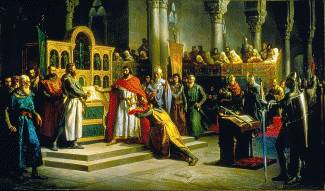
1864 Marcos Giráldez de Acosta's painting depicting the "Santa Gadea Oath". In the middle of the scene, Alfonso VI (with red cape) is swearing with his right hand on the Bible that he did not take part in the murder of his brother Sancho II, while El Cid stands as a witness in front of him.
Sancho was assassinated in 1072, as the result of a pact between his brother Alfonso and his sister Urraca. Since Sancho died unmarried and childless, all of his power passed to his brother Alfonso.
Almost immediately, Alfonso returned from exile in Toledo and took his seat as king of Castile and León. He was deeply suspected in Castile, probably correctly, of having been involved in Sancho's murder. According to the epic of El Cid, the Castilian nobility led by El Cid and a dozen "oath-helpers" forced Alfonso to swear publicly in front of Santa Gadea (Saint Agatha) Church in Burgos on holy relics multiple times that he did not participate in the plot to kill his brother. This is widely reported as truth, but contemporary documents on the lives of both Rodrigo Diaz and Alfonso VI of Castile and León do not mention any such event. Rodrigo's position as armiger regis was taken away and given to Rodrigo's enemy, Count García Ordóñez.
In 1079 Rodrigo was sent by Alfonso VI to Seville to the court of al-Mutamid to collect the parias owed by that taifa to León–Castile.[6] While he was there Granada, assisted by other Castilean knights, attacked Seville, and Rodrigo and his forces repulsed the Christian and Grenadine attackers at the Battle of Cabra, in the (probably mistaken) belief that he was defending the king's tributary. The Count García Ordóñez and the other Castilian leaders[7] were taken captive and held for three days before being released.[6]
Exile
In the Battle of Cabra (1079), El Cid rallied his troops and turned the battle into a rout of Emir Abdullah of Granada and his ally García Ordóñez. However, El Cid's unauthorized expedition into Granada greatly angered Alfonso, and May 8, 1080, was the last time El Cid confirmed a document in King Alfonso's court. This is the generally given reason for El Cid's exile, although several others are plausible and may have been contributing factors: jealous nobles turning Alfonso against El Cid, Alfonso's own animosity towards El Cid and an accusation of pocketing some of the tribute from Seville.
At first he went to Barcelona, where Ramón Berenguer II (1076–1082) and Berenguer Ramón II (1076–1097) refused his offer of service.
Moorish service
After being rejected by Ramón Berenguer II, El Cid journeyed to the Taifa of Zaragoza where he received a warmer welcome.
According to Moorish accounts:
Andalusian Knights found El Cid their foe ill, thirsty and exiled from the court of Alfonso, he was presented before the elderly Yusuf al-Mu'taman ibn Hud and accepted command of the forces of the Taifa of Zaragoza as their Master.
However, the exile was not the end of El Cid, either physically or as an important figure. In 1081, El Cid, went on to offer his services to the Moorish king of the northeast Al-Andalus city of Zaragoza, Yusuf al-Mu'taman ibn Hud, and served both him and his successor, Al-Mustain II. He was given the title El Cid (The Master) and served as a leading figure in a vibrant Moorish force consisting of Muladis, Berbers, Arabs and Malians.
In his History of Medieval Spain (Cornell University Press, 1975), Joseph F. O'Callaghan writes:
That kingdom was divided between al-Mutamin (1081–1085) who ruled Zaragoza proper, and his brother al-Mundhir, who ruled Lérida and Tortosa. El Cid entered al-Mutamin's service and successfully defended Zaragoza against the assaults of al-Mundhir, Sancho I of Aragón, and Ramón Berenguer II, whom he held captive briefly in 1082. In 1084, El Cid and the Moorish armies defeated Sancho of Aragon at the Battle of Morella near Tortosa. He was then troubled by the fierce conflicts between the Muladis of Badajoz and the Arabs of Seville.
In 1086, the Almoravid invasion of the Iberian Peninsula through and around Gibraltar began. The Almoravids, Berber residents of present-day North Africa, led by Yusuf ibn Tashfin, were asked to help defend the divided Moors from Alfonso. El Cid had probably commanded a large Moorish force during the Battle of Sagrajas, which took place in 1086, near the Taifa of Badajoz. The Almoravid and Andalusian Taifas, including the armies of Badajoz, Málaga, Granada, Tortosa and Seville, defeated a combined army of León, Aragón and Castile.
Recall from exile
Terrified after his crushing defeat, Alfonso recalled El Cid. It has been shown that El Cid was at court on July 1087; however, what happened after that is unclear. El Cid returned to Alfonso, but now he had his own plans. He only stayed a short while and then returned to Zaragoza. El Cid was content to let the Almoravid armies and the armies of Alfonso fight without his help, even when there was a chance that the armies of Almoravid might defeat Alfonso and take over all of Alfonso's lands. The reason El Cid did not want to fight was because he was hoping that both armies would become weak. That would make it easier for him to carry out his own plan which was to become ruler of the Kingdom of Valencia.
Conquest of Valencia
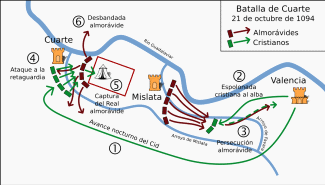
Battle of Cuarte (21 October 1094). El Cid's troops are in green, Almoravids troops are in red.
Around this time, El Cid, with a combined Christian and Moorish army, began maneuvering in order to create his own fiefdom in the Moorish Mediterranean coastal city of Valencia. Several obstacles lay in his way. First was Berenguer Ramón II, who ruled nearby Barcelona. In May 1090, El Cid defeated and captured Berenguer in the Battle of Tébar (nowadays Pinar de Tévar, near Monroyo, Teruel). Berenguer was later released and his nephew Ramón Berenguer III married El Cid's youngest daughter Maria to ward against future conflicts.
Along the way to Valencia, El Cid also conquered other towns, many of which were near Valencia, such as El Puig and Quart de Poblet.
El Cid gradually came to have more influence on Valencia, then ruled by al-Qadir. In October 1092 an uprising occurred in Valencia inspired by the city's chief judge Ibn Jahhaf and the Almoravids. El Cid began a siege of Valencia. A December 1093 attempt to break the siege failed. By the time the siege ended in May 1094, El Cid had carved out his own principality on the coast of the Mediterranean. Officially El Cid ruled in the name of Alfonso; in reality, El Cid was fully independent. The city was both Christian and Muslim, and both Moors and Christians served in the army and as administrators.
Death
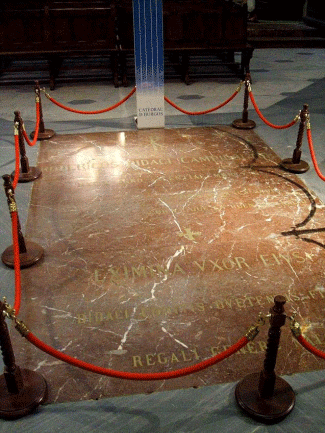
Tomb of El Cid and his wife Doña Jimena at the Burgos Cathedral, 9 August 2012.
El Cid and his wife Jimena Díaz lived peacefully in Valencia for five years until the Almoravids besieged the city. El Cid died June 10, 1099.[8] His death was likely a result of the famine and deprivations caused by the siege.[8] Valencia was captured by Masdali on May 5, 1102 and it did not become a Christian city again for over 125 years. Jimena fled to Burgos, Castile, in 1101. She rode into the town with her retinue and the body of El Cid.[8] Originally buried in Castile in the monastery of San Pedro de Cardeña, his body now lies at the center of Burgos Cathedral.
After his demise, but still during the siege of Valencia, legend holds that Jimena ordered that the corpse of El Cid be fitted with his armor and set atop his horse Babieca, to bolster the morale of his troops. In several variations of the story, the dead Rodrigo and his knights win a thundering charge against Valencia's besiegers, resulting in a war-is-lost-but-battle-is-won catharsis for generations of Christian Spaniards to follow. It is believed that the legend originated shortly after Jimena entered Burgos, and that it is derived from the manner in which Jimena's procession rode into Burgos, i.e. alongside her deceased husband.[8]
Warrior and general
Battle tactics
During his campaigns, El Cid often ordered that books by classic Roman and Greek authors on military themes be read aloud to him and his troops, for both entertainment and inspiration before battle. El Cid's army had a novel approach to planning strategy as well, holding what might be called brainstorming sessions before each battle to discuss tactics. They frequently used unexpected strategies, engaging in what modern generals would call psychological warfare — waiting for the enemy to be paralyzed with terror and then attacking them suddenly; distracting the enemy with a small group of soldiers, etc. (El Cid used this distraction in capturing the town of Castejón as depicted in Cantar de Mio Cid (The Song of my Cid). El Cid accepted or included suggestions from his troops. In The Song the man who served him as his closest adviser was his vassal and kinsman Álvar Fáñez "Minaya" (meaning "My brother", a compound word of Spanish possessive Mi (My) and Anaia, the basque word for brother), although the historical Álvar Fáñez remained in Castile with Alfonso VI.
Taken together, these practices imply an educated and intelligent commander who was able to attract and inspire good subordinates, and who would have attracted considerable loyalty from his followers, including those who were not Christian. It is these qualities, coupled with El Cid's legendary martial abilities, which have fueled his reputation as an outstanding battlefield commander.
Babieca
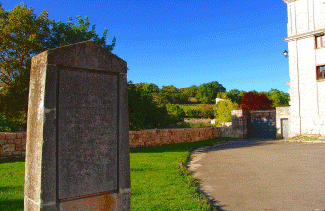
Tomb of Babieca at the monastery of San Pedro de Cardeña.
Babieca or Bavieca was El Cid's warhorse. Several stories exist about El Cid and Babieca. One well-known legend about El Cid describes how he acquired the stallion. According to this story, Rodrigo's godfather, Pedro El Grande, was a monk at a Carthusian monastery. Pedro's coming-of-age gift to El Cid was his pick of a horse from an Andalusian herd. El Cid picked a horse that his godfather thought was a weak, poor choice, causing the monk to exclaim "Babieca!" (stupid!) Hence, it became the name of El Cid's horse. Another legend states that in a competition of battle to become King Sancho's "Campeador", or champion, a knight on horseback wished to challenge El Cid. The King wished a fair fight and gave El Cid his finest horse, Babieca, or Bavieca. This version says Babieca was raised in the royal stables of Seville and was a highly trained and loyal war horse, not a foolish stallion. The name in this instance could suggest that the horse came from the Babia region in León, Spain. In the poem Carmen Campidoctoris, Babieca appears as a gift from "a barbarian" to El Cid, so its name could also be derived from "Barbieca", or "horse of the barbarian".
Regardless, Babieca became a great warhorse, famous to the Christians, feared by El Cid's enemies, and loved by El Cid, who allegedly requested that Babieca be buried with him in the monastery of San Pedro de Cardeña. His name is mentioned in several tales and historical documents about El Cid, including The Lay of El Cid.
Swords
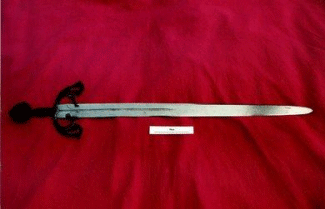
Tizona sword
A weapon traditionally identified as El Cid's sword, Tizona, used to be displayed in the Army Museum (Museo del Ejército) in Toledo. In 1999, a small sample of the blade underwent metallurgical analysis which confirmed that the blade was made in Moorish Córdoba in the eleventh century and contained amounts of Damascus steel.[9] El Cid also had a sword called Colada.
In 2007 the Autonomous Community of Castile and León bought the sword for 1.6 million Euros, and it is currently on display at the Museum of Burgos.
Marriage and family
El Cid was married in July 1075 to Alfonso's kinswoman Jimena Díaz. The Historia Roderici calls her a daughter of a Count Diego of Oviedo, a person unknown to contemporary records, while later poetic sources name her father as an otherwise unknown Count Gomez de Gormaz.
Tradition states that when El Cid first laid eyes on her, he was enamored by her great beauty. Together El Cid and Jimena had two children. Their daughters Cristina and María both married into royal families; Cristina to Ramiro, Lord of Monzón, grandson of García Sánchez III of Navarre via an illegitimate son; María, first (it is said) to a prince of Aragon (presumably the son of Peter I) and second to Ramón Berenguer III, count of Barcelona. El Cid's son Diego Rodríguez was killed while fighting against the invading Muslim Almoravids from North Africa at the Battle of Consuegra (1097).
El Cid's own marriage and those of his daughters raised his status by connecting him to the peninsular royalty; even today, most European monarchs (including the current King of Spain) and many commoners of European ancestry descend from El Cid, through Cristina's son, King García Ramírez of Navarre and to a lesser extent via a granddaughter Jimena of Barcelona, who married into the Counts of Foix.
In popular culture
• The 1961 epic film, El Cid, was a romanticized story of the life of Rodrigo Díaz de Vivar where El Cid was portrayed by Charlton Heston.
• The 1999 videogame Age of Empires 2 features El Cid as a character in his own campaign.
References
1. Jump up ^ María Jesús Viguera Molins, «El Cid en las fuentes árabes», in César Hernández Alonso (coord.), Actas del Congreso Internacional el Cid, Poema e Historia (12–16 de julio de 1999), Ayuntamiento de Burgos, 2000, págs. 55–92. ISBN 84-87876-41-2
2. See Ramón Menéndez Pidal, «Autógrafos inéditos del Cid y de Jimena en dos diplomas de 1098 y 1101», Revista de Filología Española, t. 5 (1918), Madrid, Sucesores de Hernando, 1918. Digital copy Valladolid, Junta de Castilla y León. Consejería de Cultura y Turismo. Dirección General de Promociones e Instituciones Culturales, 2009–2010. Original in Archivo de la Catedral de Salamanca, caja 43, legajo 2, n.º 72.
3. Alberto Montaner Frutos y Ángel Escobar, «El Carmen Campidoctoris y la materia cidiana», in Carmen Campidoctoris o Poema latino del Campeador, Madrid, Sociedad Estatal España Nuevo Milenio, 2001, pág. 73 [lam.]. ISBN 978-84-95486-20-2
4. Alberto Montaner Frutos, «Rodrigo el Campeador como princeps en los siglos XI y XII»
5. Georges Martin «El primer testimonio cristiano sobre la toma de Valencia (1098)», en el número monográfico «Rodericus Campidoctor» de la revista electrónica e-Spania, n.º 10 (diciembre de 2010). Online since January 22nd 2011. URL <http://e-spania.revues.org/19945> Last time visited November 28th 2011. Complete text (Edition of the Latin text) in José Luis Martín Martín & al., Documentos de los Archivos Catedralicio y Diocesano de Salamanca (siglos XII-XIII), Salamanca, Universidad, 1977, doc. 1, p. 79-81.
6. Chaytor, Henry John (1933). "Chapter 3: The Reconquest". A History of Aragon and Catalonia. London: Methuan. pp. 39–40.
7. The Historia Roderici says that the other two Castilian leaders were Diego Pérez and Lope Sánchez. de los Rios, José Amador (1863). "Capitulo 3: Primeros Monumentos Escritos de la Poesía Castellana (Chapter 3:First Written Monuments of Castilian Poetry)". Historia Crítica de la Literatura Española, Tomo III, (II Parte, Subciclo I) (The History and Criticism of Spanish Literature, Volume III, (Second Part, subpart I)) (in Spanish). Madrid, Spain: J. Rodriguez. p. 104.
8. Perea Rodríguez, Óscar. "Díaz de Vivar, Rodrigo o El Cid (1043–1099)". Retrieved 23 April 2012.
9. Alonso, J. I. Garcia; Martinez, J. A.; Criado, A. J. (1999). "Origin of El Cid's sword revealed by ICP-MS metal analysis". Spectroscopy Europe (John Wiley & Sons, Ltd.) 11 (4).
Sources
• Simon Barton and Richard Fletcher. The world of El Cid, Chronicles of the Spanish reconquest. Manchester: University Press, 2000. ISBN 0-7190-5225-4 hardback, ISBN 0-7190-5226-2 paperback.
Gonzalo Martínez Díez, "El Cid Histórico: Un Estudio Exhaustivo Sobre el Verdadero Rodrigo Díaz de Vivar", Editorial Planeta (Spain, June 1999). ISBN 84-08-03161-9
• Richard Fletcher. "The Quest for El Cid". ISBN 0-19-506955-2
• Kurtz, Barbara E. El Cid. University of Illinois.
• I. Michael. The Poem of El Cid. Manchester: 1975.
• C. Melville and A. Ubaydli (ed. and trans.), Christians and Moors in Spain, vol. III, Arabic sources (711–1501). (Warminster, 1992).
• Joseph F. O'Callaghan. A History of Medieval Spain. Ithaca: Cornell University Press, 1975
• Peter Pierson. The History of Spain. Ed. John E. Findling and Frank W. Thacheray. Wesport, Connecticut: Greenwood Press, 1999. 34–36.
• Bernard F. Reilly. The Kingdom of León-Castilla under King Alfonso VI, 1065–1109 Princeton, New Jersey: University Press, 1988.
• The Song of El Cid. Translated by Burton Raffel. Penguin Classics, 2009.
• R. Selden Rose and Leonard Bacon (trans.) The Lay of El Cid. Semicentennial Publications of the University of California: 1868–1918. Berkeley, CA: University of California Press, 1997.
• Steven Thomas. 711–1492: Al-Andalus and the Reconquista.
• M. J. Trow,El Cid The Making of a Legend, Sutton Publishing Limited, 2007.
• Henry Edwards Watts. "The Story of El Cid (1026–1099)" in The Christian Recovery of Spain: The Story of Spain from the Moorish Conquest to the Fall of Grenada (711–1492 AD). New York: Putnam, 1894. 71–91.
• Cantar de mío Cid – Spanish (free PDF)
• Poema de Mio Cid, Códice de Per Abbat in the European Library (third item on page)
• T.Y. Henderson. "Conquests Of Valencia"
• J. I. Garcia Alonso, J. A. Martinez, A. J. Criado, "Origin of El Cid's sword revealed by ICP-MS metal analysis", Spectroscopy Europe, 11/4 (1999).
